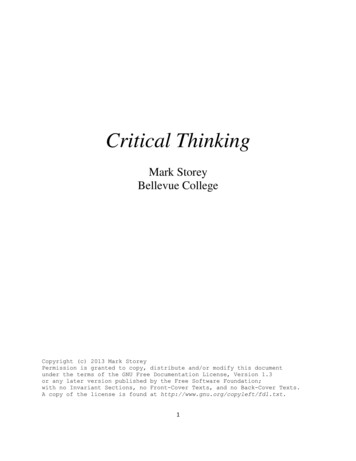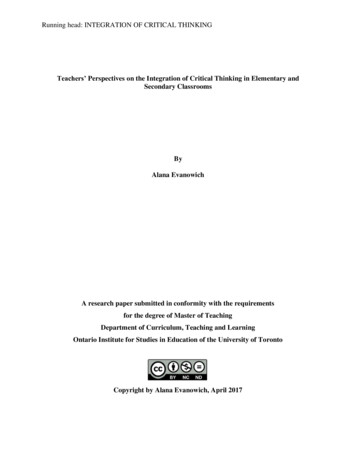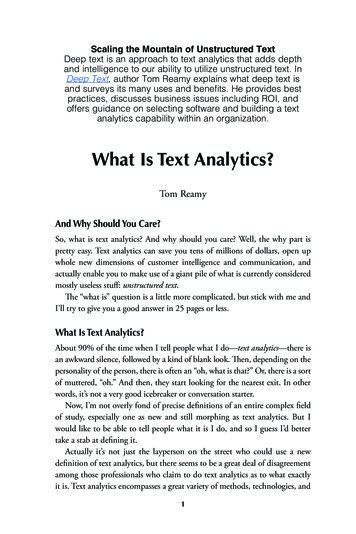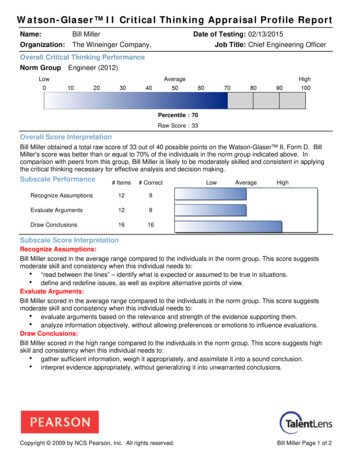
Transcription
Critical ThinkingMark StoreyBellevue CollegeCopyright (c) 2013 Mark StoreyPermission is granted to copy, distribute and/or modify this documentunder the terms of the GNU Free Documentation License, Version 1.3or any later version published by the Free Software Foundation;with no Invariant Sections, no Front-Cover Texts, and no Back-Cover Texts.A copy of the license is found at http://www.gnu.org/copyleft/fdl.txt.1
ContentsPart 1Chapter 1: Thinking Critically about the Logic of Arguments . 3Chapter 2: Deduction and Induction . 10Chapter 3: Evaluating Deductive Arguments . . 16Chapter 4: Evaluating Inductive Arguments . 24Chapter 5: Deductive Soundness and Inductive Cogency . . 29Chapter 6: The Counterexample Method . 33Part 2Chapter 7: Fallacies . . . 43Chapter 8: Arguments from Analogy 75Part 3Chapter 9: Categorical Patterns . . . 86Chapter 10: Propositional Patterns . . . 116Part 4Chapter 11: Causal Arguments. . . . . 143Chapter 12: Hypotheses. . . 159Chapter 13: Definitions and Analyses. . . 179Chapter 14: Probability . 1992
Chapter 1: Thinking Critically about the Logic of ArgumentsLogic and critical thinking together make up the systematic study of reasoning, and reasoning iswhat we do when we draw a conclusion on the basis of other claims. In other words, reasoning isused when you infer one claim on the basis of another. For example, if you see a great deal ofsnow falling from the sky outside your bedroom window one morning, you can reasonablyconclude that it’s probably cold outside. Or, if you see a man smiling broadly, you canreasonably conclude that he is at least somewhat happy. In both cases, you are reasoning fromevidence to a conclusion.We use reasoning all the time, but sometimes we make a mess out of it. Whether a line ofreasoning is good or not is definitely more than “just a matter of opinion.” Surely the reasoningin the following arguments is not compelling:* My four-year-old niece says that the planet Mars is smaller than Jupiter. It must thereby be thecase that Mars is smaller than Jupiter.* Some women are baseball fans. And some mothers are baseball fans. Thus, all women aremothers.* An earthquake occurred in San Francisco five minutes after the senator’s speech there. Thusthat senator’s voice causes natural disasters.But the reasoning in the next set of arguments is better, yes?* All bears are mammals. Grizzlies are bears. Thus grizzlies are mammals.* If Jimmy Carter was the U.S. President, then he was a politician. Carter was indeed the U.S.President. Thus, Carter was a politician.* It has rained in Seattle, Washington every year for the past 100 years. Thus it will probablyrain there next year.Some examples of reasoning are clearly better than others. The study of logic and criticalthinking are designed to make us better at recognizing good from bad lines of argumentation.An argument consists of one or more statements, called premises, offered as reason to believethat a further statement, called the conclusion, is true. Technically speaking, premises andconclusions should be made up of statements. A statement is a sentence that declares somethingto be true or false. They are thus sometimes called declarative sentences. A sentence is agrammatically correct string of words, and there are many kinds of sentences other thanstatements. Questions (e.g., “What is your name?”), commands (e.g., “Turn to page three”), andexclamations (e.g., “Ouch!”) are all grammatically correct sentences that are not statements.They are not statements because it makes no sense to say they are true or false. (“What is yourname?” “That’s true!” This would be a ridiculous mini-conversation.) Statements will always betrue or false, never both, and never neither. We may disagree on whether a given statement istrue (e.g., “God exists”), or we may not be able to determine whether a statement is true or false3
(e.g., “There is a mountain on Pluto exactly 1000 meters tall, plus or minus 2 centimeters”), yetthe statement is objectively true or false (but not both) nonetheless.In this course, the words “statement” and “sentence” can—in many contexts—be usedinterchangeably. This is so because all statements are sentences (although not all sentences arestatements). So we can refer to “Bellevue is in Washington” as both a statement (because itdeclares something to be true) and a sentence (because it is a grammatically correct sequence ofwords conveying a meaning).An argument can have any number of premises, but technically speaking there is one conclusionper argument. Thus, an argument splits into two distinct parts:1. One or more premises offer evidence for the truth of the conclusion.2. The conclusion is supported by the premise or premises.Here is an argument:All dogs are mammals.No mammals are birds.Thus, no dogs are birds.The conclusion seems well supported by the two premises. However, things are not so good inthe following argument:Some cats are animals.Some animals are fish.Hence, some cats are not fish.In both examples above, the arguments contained two premises and one conclusion, but in thesecond argument immediately above, the premises by themselves do not offer good reason tobelieve the conclusion—even if though the premises are true!Sometimes the conclusion of an argument can be used as a premise of a following argument,making a chain of arguments. Still, to be precise, each argument or specific line of inferencecontains one and only one conclusion, although each may contain varying number of premises.For instance:1. All dogs are mammals.2. All mammals are animals.3. Thus, all dogs are animals.4. Scooby-Doo is a dog.5. Thus, Scooby-Doo is an animal.6. No animals are plants.7. All trees are plants.8. Thus, Scooby-Doo is not a tree.4
Whew! Here the first argument in the chain has lines 1 and 2 as premises, and has line 3 as itsconclusion. The second argument then uses line 3 as a premise and uses it with line 4 to concludein line 5 that Scooby-Doo is a dog. The third argument then uses line 5 as a premise, hooks it upwith lines 6 and 7, and uses the trio together to infer line 8 as the final conclusion.**Practice Problems: Types of SentencesAre the following statements or not?1. George Carlin is presently president of the USA.2. Chocolate is a popular flavor of ice cream in the USA.3. Sally Brown, come on down!4. Washington State is south of Oregon.5. Bob believes that Washington State is south of Oregon.6. College students are morally obliged to believe that Washington State is south of Oregon.7. Who in Oregon is rooting for the Huskies?8. It is prudent for Duck fans not to wear green when going to a Husky game in Seattle.9. Green is an Oregon Ducks color, while purple is a Washington Huskies color.10. The Huskies are my favorite college football team!11. Go Cougars!12. The Ducks will never win the Apple Cup.13. Huskies14. Ducks vs. Cougars15. The Ducks will play the Cougars tonight.16. Slap a ham on Omaha, pals!17. Dennis and Edna sinned.18. Rats live on no evil star.19. Tarzan raised Desi Arnaz’ rat.20. Go deliver a dare, vile dog.Answers:1. statement2. statement3. not a statement4. statement5. statement6. statement7. not a statement8. statement9. statement10. statement11. not a statement12. statement13. not a statement14. not a statement15. statement16. not a statement17. statement18. statement19. statement20. not a statementIndicator WordsBefore determining whether an argument is good or bad, we need to recognize its structure. Weneed, that is, to know which claims are premises and which one is the conclusion. Indicatorwords or phrases can help us out here.A conclusion indicator is a word or phrase that, when used in the context of an argument, signalsthat a conclusion is about to be given or was just given. In the two examples above, “Thus” and5
“Hence” were used as indicators to signal the presence of the conclusion. The following aresome of the commonly used conclusion indicator words and phrases:ThereforeThusSoIn conclusionAccordinglyIt follows thatHenceErgoWe can conclude thatentails thatWe may inferimplies thatA premise indicator is a word or phrase that, when used in the context of an argument, signalsthat a premise is about to be given or was just given. Here are some examples:BecauseSinceIfProvided thatFor the reason thatforGiven thatAssuming thatDue to the fact that may be inferred fromInasmuch asis evidence foris reason to believe thatsupports the claim thatIf you want to make your reasoning as clear as possible when you present arguments, useindicator words to signal your premises and conclusions. Your audience (e.g., a teacher gradingyour essay) will appreciate it, and your reasoning will be easier to follow than it otherwise mightbe.Note, though, that some indicator words have multiple uses. The premise indicator “if,” forinstance, is often used in other ways. For example, in the sentence, “If Yogi is a bear, then Yogiis an animal,” the word “if” is used as part of a single complex statement called a conditional(i.e., an “if , then ” statement). Also, the conclusion indicator “so” can be used in many ways,such as, “I am so happy I’m studying logic!” Indicator words can be helpful, but we must still becareful in recognizing how they function in a sentence.**Practice Problems: Indicator WordsFor each argument, (a) state any premise or conclusion indicators, and (b) state the conclusion.1. Since Tuan is a student, it follows that he studies regularly.2. Sarah is a mother, because she has given birth to a child.3. All dogs are mammals, and all mammals are animals; thus all dogs are animals.4. Given that Kim is the country’s president, that Kim is a politician may be inferred from thefact that all presidents of countries are politicians.5. The ground is wet during a heavy rain. Consequently, due to the fact that it’s raining now, theground now is wet.6. Provided that two is greater than one, and three is greater than two, it follows that three isgreater than one.7. Tran is happy. Hence Tran is happy.8. Simón Bolívar was born in Venezuela. Bolívar was a military hero in South America. Thisimplies that a military hero was born in Venezuela.9. According to Socrates, people will do what they believe is in their best interests. Thus, sincethe good is in people’s best interest, it behooves philosophers to explain the good to people.10. Given that all dogs are mammals, and because no mammals are birds, it must be concludedthat no dogs are fish.6
11. Assuming that Senator Sunny Shine likes to swim, and inasmuch as today is warm and thesun is out, it follows that Sunny Shine is swimming in her backyard pool.12. Shine and her husband don’t want to unduly offend their neighbors, and their neighbors arenot fans of skinny-dipping. We may infer that Shine and her husband don’t skinny-dip whentheir neighbors are watching.13. Pastor Bustle is opposed to all skinny-dipping. Bustle is opposed to some of the Shines’activities, due to the fact that Bustle knows that the Shines like to skinny-dip.14. If Bustle climbs a ladder to look over the fence at the Shines, then Bustle will probably falland twist his ankle. Bustle does indeed climb a ladder to look over the fence at the Shines. Thisentails that Bustle will probably fall and twist his ankle.15. Either Bustle gets away with voyeurism or the police fail to charge him with a misdemeanor.Since the police do fail to charge Bustle with a misdemeanor, Bustle accordingly gets away withvoyeurism.Answers:1. (a) Since; it follows that; (b) he studies regularly2. (a) because; (b) Sarah is a mother3. (a) thus; (b) all dogs are animals4. (a) Given that; may be inferred from; (b) Kim is a politician5. (a) Consequently; due to the fact that; (b) the ground is now wet6. (a) Provided that; it follows that; (b) three is greater than one.7. (a) Hence; (b) Tran is happy (the second instance of the claim)8. (a) This implies that; (b) a military hero was born in Venezuela9. (a) Thus; since; (b) it behooves philosophers to explain the good to people10. (a) Given that; because; it must be concluded that; (b) no dogs are fish11. (a) Assuming that; inasmuch as; it follows that; (b) Sunny Shine is swimming in herbackyard pool.12. (a) We may infer that; (b) Shine and her husband don’t skinny-dip when their neighbors arewatching13. (a) due to the fact that; (b) Bustle is opposed to some of the Shines’ activities14. (a) This entails that; (b) Bustle will probably fall and twist his ankle15. (a) Since; accordingly; (b) Bustle accordingly gets away with voyeurismDistinguishing Arguments from Non-argumentsWe probably will not understand what an argument is unless we can tell the difference betweenan argument and a non-argument. This is why the ability to distinguish arguments from thingsthat are not arguments is an important skill in logic.An argument is someone’s reasoning expressed in the format of a language. When an argumentis given, one or more reasons are being offered for a conclusion. However, there are many thingswe do with language besides reason. We use language to describe things, to explain things, toexpress our feelings, to give orders, to ask questions, to tell stories, to give advice, to offerreports, to babble incoherently, and on and on. None of these activities involves logicalargumentation; none constitutes giving an argument. Essentially, in the case of a non-argument,7
someone is not trying to prove a point—someone is not offering a reason to believe a claim thatis being advanced, someone is not offering evidence for a conclusion, while in the case of anargument, someone is offering reasons in support of a conclusion, reasons to believe that a claimis true.**Practice Problems: Arguments and Non-argumentsIn each case, does the passage present an argument or a non-argument?1. Elizabeth and Marty went together to school on Tuesday, got in a minor automobile accident,and were late for their biology class. Their teacher was giving a test that day, and the twostudents were not there to take it.2. Elizabeth and Marty left their house to go to school on Tuesday, but on the way decided tospend the day at the movie theater instead. Their biology teacher was giving a test that day, andthe two students were not there to take it. That is why they received a poor grade for theircoursework that week.3. Elizabeth and Marty, you two are crazy! You should not have gone to the movies Tuesday,especially when you had a test in your biology class. You should go to school each day classesare in session.4. Elizabeth and Marty went together to school every day this week and studied the materialcovered in class. Students who attend class regularly and study regularly usually do well in class.Thus Elizabeth and Marty probably did well in class this week.5. Some students do not attend class regularly. For instance, Elizabeth and Marty went togetherto school on Tuesday, but decided to return home to play Grand Theft Auto all day. Suchbehavior is indicative of poor study habits.6. Maria studies every night for her chemistry class, and works very precisely in her chemistrylab work. She also attends class each day and takes complete notes. We can conclude that Mariawill likely do well in her chemistry class.7. Both Mahatma Gandhi and Sri Aurobindo were philosophically minded, both were male, bothwere from India, and both wrote commentaries on the Bhagavad Gita. Gandhi fought againstBritish occupation of India. Thus probably Aurobindo did, too.8. Rene Descartes had trouble seeing the relations between things in Nature, focused on breaking“problems” into smaller parts, and missed viewing systems holistically. Thus he has beendeemed a “mechanistic” philosopher.9. Fatima likes pizza. Julio likes football. Takashi likes reading The Tale of Genji.10. Sunzi wrote The Art of War, and The Art of War was written by a Chinese philosopher. Sunzimust therefore be a Chinese philosopher.Answers:1. Non-argument. It’s merely a report of the day’s events with no inference.2. Non-argument. It’s a causal explanation of the students’ poor grades with no inference.3. Non-argument. It’s a combination of opinion and advice, but with no inference.4. Argument. There are a series of claims serving as premises leading to a conclusion (note theindicator word “thus”).5. Non-argument. It’s merely an illustration of the opening claim with no inference.6. Argument. Note the use of the conclusion indicator, “We can conclude that.”8
7. Argument. This is an argument from analogy.8. Non-argument. We find the word “thus” (which is often a conclusion indicator), but here it ispointing to the effect of a causal relation. That is, the final statement is explained by the previousones, but there is no inference intended here.9. Non-argument. It’s just an unconnected string of claims.10. Argument. The two claims in the first sentence offer reason to believe the claim in the finalsentence. Also, “therefore” is functioning as a conclusion indicator.9
Chapter 2: Deduction and InductionLogicians divide all arguments into two broad categories: deductive arguments and inductivearguments. Every argument falls into one of these two categories. Of course people offeringarguments often do not fully understand what they are doing. That is, they may be unclear howpowerful their arguments could be, assuming they are arguing well. Still, once we understandwhat their arguments are, it’s usually not difficult to determine if each is best understood asdeductive or inductive.Deductive ArgumentsA deductive argument claims (explicitly or implicitly) that if the premises all are true, then theconclusion must be true. Deductive arguments thus aim to establish their conclusions withcomplete certainty in such a way that the conclusion is guaranteed to be true if the premises allare true. Note that the argument may fail in its aim; what makes the argument deductive is that itis the kind of argument that—if it were successful—would have the premises absolutelyguarantee the conclusion to be true.The following four arguments are all deductive:* All bats are cute animals. No cute animals are mean. So, certainly, no bats are mean.* Joan is Lauren’s mother. Therefore, Joan must be older than Lauren.* Nobody knows Ned. Therefore, it must be that Ned does not know himself.* Some cats are pets. Thus, some pets must be cats.Inductive ArgumentsAn inductive argument claims (explicitly or implicitly) that if the premises all are true, theconclusion is thereby probably, or likely, true, although not absolutely guaranteed. Inductivearguments thus aim to establish their conclusions with probability, or likelihood, but not withcomplete certainty. An inductive argument does not attempt to guarantee that its conclusion istrue; however, it aims to show that we have good reasons to accept the conclusion as truenevertheless. “Probably,” in this context, means greater than 50 percent chance. Admittedly,quantifying the likelihood of a conclusion being true is not always easy, but “better than a 50percent chance” gets the idea across. Note that the inductive argument may fail in its aim; whatmakes the argument inductive is that it is the kind of argument that—done well—can give goodbut less than 100 percent conclusive reason to believe the conclusion.Examples of induction are found in everyday life, where people use less than guaranteedreasoning to go about their daily business. You’ve never (or rarely) been poisoned at the schoolcafeteria, so you feel safe eating there later today. Your past experiences do not absolutelyguarantee that you won’t get sick eating there today, but you will eat there nonetheless and beperfectly rational in doing so. You’ll be using a strong form of inductive reasoning. Thefollowing four arguments are also inductive:10
* Pat and Jan are lifelong best friends. So Jan probably knows Pat’s parents.* It has been sunny for ten days in a row, and there are no clouds in the sky. So probably it willbe sunny tomorrow.* Joe hasn’t had a drink in ten years. So it is likely he won’t drink at the party tonight.* Most dogs are loving animals. Fido is a dog. Therefore Fido is probably a loving animal.Deductive or Inductive?Sometimes it is difficult to tell whether a person’s argument is deductive or inductive becausethe reasoning is not clearly stated. When trying to decide whether an argument is deductive orinductive, a good rule of thumb is to ask yourself: Is the arguer aiming to show that theconclusion is guaranteed to be true, or is he or she aiming only to show that the conclusion islikely to be true, i.e., is probably true but less than certain? If the arguer’s reasoning is expressedclearly, then there will often be words or other clues indicating which type of argument(deductive or inductive) is intended. If a deductive argument is intended, then the conclusionmay be introduced with words or phrases indicating necessity or certainty, such as:It is certain thatAbsolutelyUndeniably, it must be thatFor sureIt is necessarily true thatHowever, if an inductive argument is intended, then the conclusion may be introduced withwords or phrases indicating probability, such as:The most reasonable conclusion isProbablyIt is likely thatIt is reasonable to suppose thatI’ll bet thatSome common phrases are found in both deductive and inductive arguments, and thus do nothelp much in determining which kind of argument you are dealing with. “It must be the casethat” is an example of a phrase you often find attached to both premises and the conclusion, ofboth deductive and inductive arguments.Notice, though, that whereas deductive arguments have an air of certainty, confidence, andconclusiveness, inductive arguments have an air of uncertainty and incompleteness. While adeductive argument claims its conclusion must be true, and with certainty, an inductive argumentclaims only that if its premises all are true then its conclusion is probable although notcompletely certain.11
If everyone were honest or understood inductive and deductive indicator words, and if everyoneoffering an argument used such vocabulary accurately, we’d have a fairly easy time determiningif arguments are intended as inductive or deductive. But none of this is the case, unfortunately.Too many people don’t understand or care about the difference between induction and deduction,or try to overstate the strength of their inductive position by couching their arguments indeductive indicator words. We need additional hints to be confident that we are dealing with adeductive (or inductive) argument.Argument PatternsSince so few people use indicator words at all or correctly, it’s of great use to become familiarwith patterns of argument that usually are associated with deduction or induction. These tips arenot fail-safe, as occasionally odd counterexamples can be imagined. Still, the patterns providegood reason for saying that a given argument is deductive, or inductive. Examples of suchpatterns include the following.Deductive patterns:* Arguments based on mathSince we know basic math truths (e.g., 2 2 4) with our highest degree of certitude, anyargument based (not merely about) math will have a similar degree of certitude.E.g., Joe passed two touchdowns in the first half of the football game, and he passed onetouchdown in the second half of the game. Thus Joe passed three touchdowns in that game.E.g., This Euclidian triangle has one right interior angle and one 10 degree interior angle. Thusthe third interior angle must be 80 degrees.Note: The following argument is not based on math, it is about math; it is not deductive: “All mymath teachers say that two plus two equals four. Thus two plus two equals four.”* Arguments based on definitionsIf an inference is based on the definition of a word, then (even if the definition is mistaken) theargument is best understood as deductive.E.g., Sara is a physician. Thus Sara is [by definition] a doctor.E.g., This shirt is damp. Thus this shirt is moist.E.g., Bob has no hair on his head. Therefore Bob is bald.* Categorical syllogismsA syllogism has two premises, and a categorical syllogism is a two-premise argument in whicheach premise and the conclusion begin with the words “All,” “No,” or “Some,” in anycombination.E.g., All dogs are hairy things, and all hairy things are mammals. Thus all dogs are mammals.E.g., No dogs are cats. Some cats are white animals. Thus some dogs are not white animals.* Conditional syllogismsA “conditional syllogism” is a two-premise argument in which at least one premise is an “if ,then ” statement, known as a conditional, or implication.12
E.g., If Yogi is a bear, then Yogi is an animal. Yogi is a bear. Thus Yogi is an animal.E.g., If it rains today, then the picnic is canceled. If the picnic is canceled, then I’ll be sad.Hence, if it rains today, then I’ll be sad.* Disjunctive syllogismsA disjunction is an “ or ” statement, so a disjunctive syllogism is a two-premise argument inwhich one of the premises is an “ or ” statement (with or without an “either”).E.g., Either Bob is logical or Sue is happy. But Bob is not logical. Therefore Sue is happy.Inductive patterns:* PredictionsIf the conclusion is a prediction (about the future), then it is likely an inductive argument, sincewe cannot know the future with total certainty.E.g., It has rained every day for the past five weeks. Thus it will probably rain tomorrow, too.* Arguments from analogyAn argument from analogy compares two things or two groups of things, notes many relevantsimilarities between the two, and concludes that probably what is known to be true of one will betrue of the other.E.g., I’ve eaten at Dick’s Drive-In 20 times this past month and enjoyed my dining experienceeach time. Dick’s has not changed recently in any relevant way, so I will likely enjoy my diningexperience at Dick’s when I go there later today.E.g., After studying only one night beforehand, I’ve aced the last three logic quizzes in this class.So even though I’ve studied only one night for this class’s upcoming logic quiz, I’ll probably aceit, too.* Appeal to authorityAn appeal to authority argues that because an expert says such-and-such, then such-and-such islikely to be true. As long as the expert is truly expert (i.e., authoritative) in his, her, their, or itsfield, then the argument can be quite strong.E.g., Every biology instructor will say that mice are mammals. Thus we have good reason tobelieve that mice are mammals. (A strong argument, because biology instructors are veryknowledgeable on such matters.)E.g., My chemistry teacher says that God does not exist. We can conclude that God does notexist. (A weak argument, because (a) chemistry teachers qua chemistry teachers are not expertson God’s existence, and (b) it makes little sense to consider anyone an expert on God’sexistence. The same would be the case if the teacher had said that God does exist. If thechemistry teacher came up with a good argument against (or for) God’s existence, then perhapsthat argument might give us good reason to disbelieve (or believe) in God.E.g., The Washington State highway sign we just passed said that we’re entering the city ofSeattle. Thus we are probably entering the city of Seattle. (A strong argument, as state highwaysigns are usually reliable regarding city names.)* Generalizations13
Think of polls as common examples of generalizations. You determine that something is true ofa portion of a group, and conclude that the same thing must be true of the group as a whole.E.g., Twenty percent of my Bellevue College logic students are fans of Miles Davis. Thus twentypercent of Bellevue College’s students are fans of Miles Davis.E.g., Most Roman Catholics living in North Bend, Washington believe in a Christian concept ofGod. Thus most people in the world believe in a Christian concept of God.* Causal argumentsA causal argument appeals to well-known causal relations to argue from cause to effect or fromeffect to cause. Police detectives do this when they see a crime scene with effects (e.g., a deadbody with a knife in its back) and try to argue towards the cause (e.g., who did it, why, when,how, etc.). Doctors and auto mechanics trying to figure out the cause of a medical or mechanicalproblem argue the same way.E.g., I placed a jug of water in my freezer last night. Thus that jug of water is now likely frozen.(The argument here is from cause to effect.)E.g., The instructor just passed back our logic tests, and Maria is holding hers and smiling. Iconclude that she must have received a high score on that test. (The argument here is from effectto cause.)An argument can fit more than one pattern, and that’s not a problem. For instanceMy trustworthy wife said that she will buy some bread this evening. Thus she will likely buysome bread this evening.This argument is an appeal to authority and its conclusion is a prediction. It’s quite clear that it’sbest understood as inductive. The indicator word “likely” makes its inductive nature all the moreclear.If an argument clearly fits both an inductive and a deductive pattern, then it’s generally safe tofigure the argument is deductive. This is because if an argument is constructed so that if thepremises are true the conclusion can be guaranteed to be true, it will also be the case that theconclusion is likely true. If a conclusion is sure to be true, then it’s obviously going to beprobably true. But only deductive arguments have premises that absolutely guarantee theconclusion; so if an argument can do that, it’s deductive. For example:If a blizzard dropped four feet of snow on the city park last night, then today’s picnic will becanceled. A blizzard did indeed drop four feet of snow on the city park last night. Thus, today’spicnic will be canceled.The argument fits both the conditional syllogism pattern for deduction and the predicti
* Some women are baseball fans. And some mothers are baseball fans. Thus, all women are mothers. * An earthquake occurred in San Francisco five minutes after the senator’s speech there. Thus that senator’s voice causes natural disasters. But the reasoning in the next set of arguments is b










